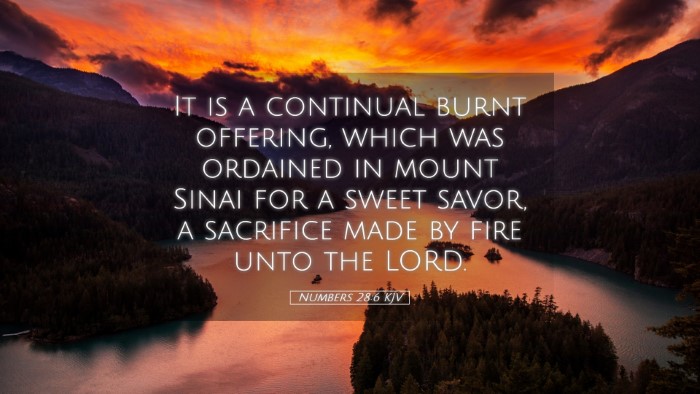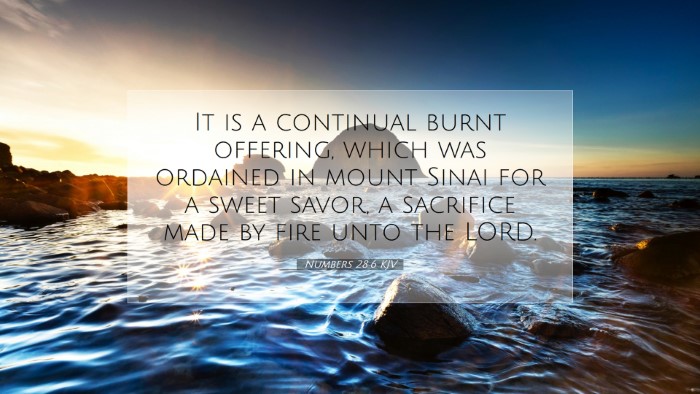Commentary on Numbers 28:6
Numbers 28:6 states, "It is a continual burnt offering, which was offered in mount Sinai for a sweet savor, a sacrifice made by fire unto the Lord." This verse succinctly encapsulates the importance of the continual burnt offerings as prescribed in the Law of Moses. The practice of burnt offerings reflects the relationship between God and His people, designed to maintain holiness and appease divine judgment.
Introduction
This verse comes as part of a larger section in the Book of Numbers that outlines the various offerings required by the Israelites. These offerings were not only rituals but were deeply symbolic of their covenant relationship with God. By looking at the insights of various biblical commentators, we can gain a more profound understanding of the theological and practical implications of this verse.
Insights from Matthew Henry
Matthew Henry emphasizes that the burnt offerings were integral to the worship system of Israel, establishing a vital means of atonement. He notes:
- Symbol of Atonement: The burnt offerings symbolized total dedication and atonement for sin. They represented the worshiper’s surrender, demonstrating their desire to be reconciled with God.
- Continual Nature: Henry comments on the "continual" aspect of this offering, highlighting its importance in daily worship, suggesting that God's presence should be a constant in the believer's life.
- Sweet Savor: The mention of a "sweet savor" indicates that these offerings were pleasing to God, which illustrates how the Lord received the genuine expressions of faith from His people.
Insights from Albert Barnes
Albert Barnes provides a detailed analysis of the sacrificial system. He explains that:
- Type of Jesus Christ: These offerings serve as a type of Christ, the ultimate sacrifice whose eternal atonement fulfills the need for continual offerings.
- Communal Responsibility: Barnes stresses that the burnt offerings were not just individual acts of worship but shared experiences that maintained communal holiness and unity among the Israelites.
- Alignment with God's Will: He further highlights that the offerings were meant to align the worshipers with God’s will, creating a space where God could communicate and dwell among His people.
Insights from Adam Clarke
Adam Clarke offers a critical perspective, particularly regarding the ceremonial law and its implications for New Testament believers:
- Historical Context: Clarke provides background on the historical context of offerings at Sinai, linking them to the broader Abrahamic covenant and God’s desire for interaction with humanity.
- Fulfillment in Christ: He sees a profound fulfillment in Christ, asserting that the continual burnt offering illustrates the necessity for continual devotion and the embodiment of sacrifice in Jesus' work on the cross.
- Fresh Revelation: Clarke also points out that these offerings were a means through which God revealed His character, portraying Him as both just and merciful.
Theological Significance
The continual burnt offerings as described in Numbers 28:6 carry significant theological weights:
- Atonement: These sacrifices illustrate the necessity for atonement, prefiguring the perfect sacrifice of Christ, who fulfills God's demand for justice in regard to sin.
- Divine Relationship: They reflect the reality of a relationship with God, emphasizing committed worship and seeking His presence continually.
- Community Worship: The offerings demonstrated a communal effort to maintain a proper relationship with God within the entire nation, aligning each person's devotion with God’s plans.
Practical Application for Pastors and Leaders
For pastors and church leaders, several practical applications emerge from Numbers 28:6:
- Cultivating Continual Worship: Encourage congregations to develop a habit of continual worship, recognizing that engaging in a relationship with God is a daily endeavor.
- Understanding Sacrifice: Teach the significance of sacrifice, past and present, guiding believers in understanding how their lives can reflect Christ's sacrifice.
- Community Dynamics: Foster a sense of community within the church, reminding members that their individual acts of devotion contribute to the overall health and spirituality of the congregation.
Concluding Thoughts
Numbers 28:6 provides a glimpse into the rich tapestry of Israel’s worship practices, revealing underlying principles that resonate throughout Scripture. Burnt offerings symbolize not just old rituals but foreshadow the greater themes of sacrifice, atonement, and the enduring presence of God in the life of His people. Understanding these insights can transform the way we approach worship and our relationship with God in the modern context.


